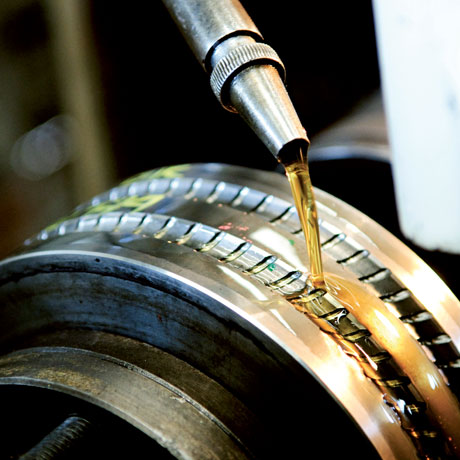Stearic acid in daily life
molecular structure of stearic acid

molecular structure of stearic acid
In general, the applications of stearic acid exploit its bifunctional character, with a polar head group that can be attached to metal cations and a nonpolar chain that confers solubility in organic solvents. The combination leads to uses as a surfactant and softening agent. Stearic acid undergoes the typical reactions of saturated carboxylic acids, a notable one being reduction to stearyl alcohol, and esterification with a range of alcohols. This is used in a large range of manufactures, from simple to complex electronic devices.

candle is one of so many materials that created by stearic acid
In our domain, candlemaking, Stearic acid is available in powder or granulated form, has a pure white color and feels a little fat when you touch it. Its melting point is 158 ∘F.
It is mainly used:
☢to raise the melting point of the paraffin it gets mixed with (logically, one part paraffin with a melting point of 130∘F mixed with one equal part paraffin with a melting point of 150∘F results in a mixture whose melting point averages 140∘F). Adding a substance with a high melting point like stearin to paraffin has a tendency to raise the average melting point of the mixture,on the contrary, to lower the melting point of a high melting point paraffin,
☢to give the colors a pastel shade,
☢to "harden" the candle. Stearin can act as a hardener
☢to make the candle burn longer (due to the fact that the melting point is higher).
CAUTION!
Stearin should not be used in combination with rubber or latex molds because it might "eat them up" (it is an acid, after all). If you're planning on using rubber molds, replace stearin with Vybar.
The proportion of stearin you will use depends on the effect you're looking for. As a hardener, the common proportion is 3 teaspoons per pound (453 grams) of paraffin.Used in higher proportions, stearin will opacify the wax, thus the finished candle too.

lubricants for engine is consisting stearic acid
In view of the soft texture of the sodium salt, which is the main component of soap, other salts are also useful for their lubricating properties. Lithium stearate is an important component of grease. The stearate salts of zinc, calcium, cadmium, and lead are used to soften PVC. Stearic acid is used along with castor oil for preparing softeners in textile sizing. They are heated and mixed with caustic potash or caustic soda. Related salts are also commonly used as release agents, e.g. in the production of automobile tires.

cosmetics contain stearic acid too
Stearic Acid is considered a low to moderate hazard ingredient by the Cosmetics Database, which notes concerns regarding cancer, and lesser concerns regarding neurotoxicity, organ toxicity and irritation. One or more animal studies showed brain and nervous system effects, respiratory effects and skin irritation at very low doses, and in vitro tests on mammalian cells show positive mutation results (leading to its designation as a potential carcinogen). However, Stearic Acid is generally considered a safe and mild ingredient when it is concentrations below limits that have been shown to cause irritation.

firework use stearic acid to "mask" the iron and aluminium to save it longer
As we know , stearic acid is an acid from group Carboxilic Acid , from its chemical properties and it characteristic , stearic acid classified as a reductor compound or also known as antioxidant compound . This characteristic could make stearic acid has a power to protect any compound from oxidation , for example in the fireworks . Fireworks usually use stearic acid to "mask" the iron , aluminium , or magnesium that will give the various colour when the firework is being burned . why we need to protect it with stearic acid mask ? because if weren't protect it , those metal would be oxidated by the oxygen in the air and changed into another compound that probably will not produce the colour that we want from the firework.
And this characteristic supports stearic acid to be the most useful compound that could being used in the cosmetic sector, industrial sector, food sector , and so on .

soap is consisting stearic acid
Stearic acid is a compound that could be a conditioner agent for soap structure , colour , and stucture . stearic acid could give the viscosity that we want for our soap , we can make a liquid soap or solid soap by changing the concentration of stearic acid inside it . stearic acid also give "pearly" colour to most of soap that we know , it could be happened because the chemical characteristic of stearic acid . the hydrocarbon that contained in stearic acid chain , could be the "Dirty Lifter" agent to clean up our body , stearic acid is higly soluble in water , so it could clean up our body without lefting the soap in our skin . duo to the fact that stearic acid is antioxidant agent , it could make the soap that contain stearic acid healtier and give anti-aging effect for our skin .

NSAID usually contain stearic acid too
NSAID (non-steroid anti-inflamasi ) usually contain stearic acid .Because of their reported antiviral and anti-inflammatory activities, cream formulations containing n-docosanol (docosanol) or stearic acid were tested for effects on chemically-induced burns in mice. In this model, injury was induced by painting the abdomens of mice with a chloroform solution of phenol. This was followed by the topical application of test substances 0.5, 3, and 6 hr later. Progression of the wounds was assessed by a single evaluator after 8 hr, using a numerical score of gross morphology. Docosanol- and stearic acid-containing creams substantially and reproducibly lessened the severity and progression of skin lesions compared to untreated sites with a 76% and 57% reduction in mean lesion scores, respectively. Untreated wounds appeared red and ulcerated; docosanol cream-treated wounds showed only slight erythema.
© 2018 Maintained by Aliefi Mutiara Syafitri, All Right Reserved